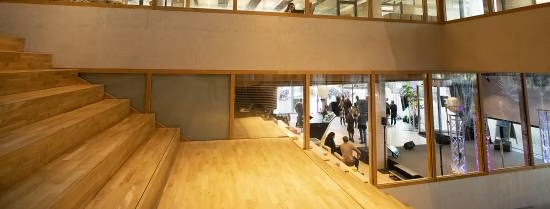Holograms of people being able to interact with a live audience- once just something you would see in movies, but now could it be the future of education? Read more about the Network Lunch that took place on 21 September at the Erasmus Education Lab, where Project Lead Bram van Essen introduced the Holobox and its potential uses in education.

Making holograms more than just an idea
Walking into the Education Lab, you may have noticed a new addition- a big, black rectangular box, with various projections inside. This is the Holobox, a tool that helps project life-sized holograms of people and objects. The Holobox works with the desired projection being filmed against a white backdrop, with a bright light facing the subject. This is then projected into the box, and the shadows emerging from the bright light give the illusion of a three-dimensional hologram. The person that is projected into the Holobox is also given a sound system, which connects to the camera and microphone at the top of the Holobox. This way, the person can see, hear, and interact with the audience viewing the Holobox in real time.
“We are also able to project other things, such as animations, in the Holobox”, explains Bram van Essen, who is the project manager for the project ‘Proof of Value for Holographic Telepresence’. “For example, an animation of a beating heart. This can be taken apart to show the different parts of the heart during a lecture for example, and the parts can be rotated within the Holobox to show all its sides."
What is the potential added value for education?
Presenter Bram van Essen shares that the project aims at exploring the added value that technology such as holograms can provide to the traditional teaching experience. The project is proposed for the duration of one academic year, where it is planned to have 1-2 Holoboxes in four different educational settings, in multiple events. Together with the partners of this project, such as TUDelft and Risbo, research will be done to gather the experiences of teachers and students who interact with the Holobox. “The four main parameters that will be looked at are immersiveness, quality of education, quality of transfer of knowledge, and the expected costs and benefits” explains Bram. The ultimate goal is to establish the added value for the box through the research report and to establish procedures that make using the Holobox easy for teachers.
Testing out the Holobox
Toward the end of the Network Lunch, participants were asked to come up and try the Holobox if they wanted to experience being “inside”. Going into the recording studio, they were given a microphone and a headset through which they could communicate to the audience standing in front of the Holobox in the other room. The volunteers testing the Holobox mentioned that they could see and hear everyone in the other room in real-time, making a lively conversation easy to facilitate. The questions and answers flowed with no delays, and the quality of recording equipment, combined with the bright light, made the participants’ hologram look very realistic.
The Holobox can show recordings in real time, but it can also play pre-recorded videos. This is particularly useful for skills trainings, as participants can see a life-sized version of themselves, to learn and improve their public speaking and body language. “Eye contact is a bit different, as you have to look straight at the camera for that to come across in the video”, one participant noted. This use of the Holobox will be trialed soon at a LifeVersity workshop, where participants will be able to improve their public speaking skillset using this technology.
Where can you expect the Holobox to pop up around campus
As of now, the CLI is in touch with faculties across the university to launch a pilot for the Holobox in an educational setting.
If you are interested to learn more about the Holobox and would want to use it within your educational activities, contact Bram van Essen.
- Related content
- Related links
- More CLI news
